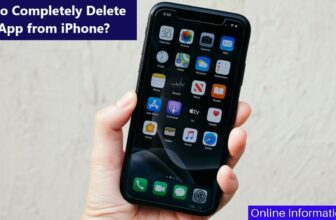Have you ever looked at your phone and pondered what those mobile internet symbols like G, E, 3G, HSPA, H+, 4G, LTE, and 5G letters on the top-right corner of the screen mean? They're internet symbols for mobile phones.
You must have been a long-time mobile internet user who has seen letters like G, E, and H as well as 2-character symbols like 2G, 3G, and 4G in numerous locations. For some people, these symbols have a deeper meaning than they realize.
However, this is understandable. Because our mobile devices are no longer solely for making phone calls, many of them can now connect to the internet, thanks to the same telecommunications firms that provide them with the capacity to make phone calls.
Not all internet mobile connectivities, however, are the same. In the same way that a device's ability to make and receive calls is determined by its network provider's coverage, the quality of the internet for the same device is determined by the technology available in the area.
For example, one person in a rural region may receive an H+ symbol on his device while another in the city receives 4G. Anyone who knows their Evolved HSPA from their LTE will notice a significant difference in data transfer speeds, with the latter being superior.
However, in addition to H+ and 4G, there are other symbols that signify the grade of internet connectivity you are getting from your network provider. What do these mobile internet symbols actually mean?
You may also like to read:
Mobile Network Signs and Their Performance
The various mobile network sign represents each generation of mobile network generations or their versions. For a general guide, you can figure out their corresponding download speed with each letter (mobile network).
| Network Signs | Network | Maximum Speed |
| G | 2G | 114 kbps |
| E | 2.5G | 400 Kbps |
| 3G | 3G | 3.1 Mbps |
| H | 3.5G | 7.2 Mbps |
| H+ | 3.5G | 21 Mbps |
| 4G | 4G | 150 Mbps |
| 4G+ | 4.5G | 450 Mbps |
| 5G | 5G | 40 Gbps |
You can see that there is less improvement in internet speed between the G and E networks which both operate under the 2G standard. The bandwidth speed itself is measured in Kbps. The 3G exceeds them and the measurement of speed is denoted in Mbps. Meanwhile, 4G adds more speed to the regular 3G network. The greatest 5G has dwarfed the capacity of 4G with a throughput capacity of Gbps.
However, the real-life speed of each network depends on a lot of factors. Phone support for the number of antennae, number of users on the network, signal strength, spectrum bandwidth, and other factors can significantly influence the broadband performance you receive.
How do mobile networks work?
Mobile networks work through a complex system that involves base stations transmitting radio waves within a hexagonal area – known as a ‘cell’ (hence mobiles also known as cellular phones).
Thousands of cells overlap across geographical areas, aiming to eliminate any areas without signal – if you were ever out of range of a cell, you’d have no signal whatsoever on your phone.
These cells are able to send and receive transmitted data and information, picking up and delivering communications between mobiles.
Let's take a look at the timeline of how the mobile internet came to be, starting with its earliest use, in chronological sequence.
GPRS or letter G
Letter G stands for GPRS (General Packet Radio Service). It indicates the slowest speed of Internet data transfer on your mobile phone. When you see G near your signal strength indicator, it is certain that your net connection is working at the slowest speed.
GPRS is considered to be the second-generation (2G) mobile technology. It is the slowest and oldest among all mobile technologies. It is mainly good enough for sending text messages using apps like WhatsApp. Data rates in GPRS are between 56 and 114 kbit/second.
If your mobile signal is weak, you might get an even slower speed on the Internet.
EDGE or the letter E
Most people refer to the letter E or EDGE (Enhanced Data Rates for GSM Evolution) as “2.5G” because it is in the middle of 2G and 3G.
Despite the fact that this more advanced technology is far superior to GPRS, this level of connectivity is still insufficient for a satisfactory web browsing experience.
EDGE data rates typically range from 400 kbps to 1Mbps. While it can certainly load online pages quickly, the wait time is often excruciatingly long owing to network and other background issues.
With the launch of the GSM standard-based Universal Mobile Telecommunications System or 3G, the third generation of mobile internet began to mature. Although the slowest data rate for a 3G connection may be as low as 384kbps for EDGE, an optimal 3G connection can reach 42Mbps.
The optimal speed of 3G enables smooth browsing of the internet, as well as music, and video streaming, as well as downloading and uploading.
3G – HSPA stands for the letter H.
The upgraded 3G technology known as High-Speed Packet Access (HSPA), simply indicated as “H” on the mobile signal bar, improves upon the ripeness of 3G, paving the door for a good mobile web browsing experience.
While HSPA may appear to be a wonderful idea on paper, it is the later, more advanced version that makes it a far better alternative to 3G in the form of HSDPA (High-Speed Downlink Packet Access). An HSDPA connection can deliver a rapid download speed of 99 Mbps under ideal conditions.
H/H+ or WCDMA
WCDMA is a type of 3G connectivity that isn't necessarily a stand-alone technology. However, because of its widespread use, it is worth noting that this technology exists. Wide-band Code-Division Multiple Access is the abbreviation for Wide-band Code-Division Multiple Access.

H+ (or Evolved HSPA) is a type of HSPA that has evolved over time.
The industry did not stop refining mobile technology, even with the advantages of HSPA, which led to the development of a better version, Enhanced HSPA or H+.
Enhanced HSPA serves as a common replacement in many regions when the dominant mobile technology, 4G (which will be covered later), is unavailable. Uplink speeds of up to 22 megabits per second are possible, with downlink speeds of up to 42.2 megabits per second.
Using H+, you’ll probably be able to use your phone as normal in terms of internet, text, and call usage – you just might notice the speed is slightly slower than 4G.
VoLTE
If you are on a call and see the VoLTE sign, then you are using the HD call over the 4G network. VoLTE is the next-gen call service that offers HD audio calling on 4G. The fourth-gen network doesn’t have default support for voice calls.
Whenever you dial a number, your mobile network falls back to 3G or lower networks to arrange the call. However, with VoLTE, you can not only make a call while on 4G, but you can also enjoy surfing the internet simultaneously.
LTE or 4G
As I previously stated, we are now in the fourth generation of mobile technology, sometimes known as 4G or LTE (Long Term Evolution). This is especially true given how long we've been using this technology, as indicated by the arrival of 5G mobile communication.
While the fifth generation is already here, the 4G is worth paying attention to because of its greater conveniences than earlier technologies.
LTE is the epitome of rapid internet connectivity using a mobile device according to current standards. When you see 4G around your device's bar signal, you know you're on this form of connection. It's also possible that you're on this type of connection if you experience seamless internet surfing, very rapid download speeds, and uninterrupted high-quality video streaming.
Recommended for you:
5G
5G refers to the next generation of mobile internet. 5G allows for the creation of a new type of network that connects nearly everyone and everything, including machines, objects, and gadgets. 5G wireless technology is designed to provide multi-gigabit per second peak data speeds, ultra-low latency, greater stability, huge network capacity, increased availability, and a more consistent user experience for a larger number of users. Higher performance and efficiency allow for new user experiences and industry connections.
Average download rates of roughly 1 gigabit per second or higher are projected once the 5G network comes globally in the next three years, as the network is capable of handling up to 20-30 gigabits per second.
5G provides services that are categorized into the following three categories.
- Extreme Mobile Broadband (eMBB): It is a non-standalone architecture that provides high-speed internet connectivity, greater bandwidth, average latency, UltraHD video streaming, augmented reality, virtual reality (VR/AR) media, etc.
- Massive Machine Type Communication (mMTC): It offers long-range and broadband machine-type communication with less power consumption at a very cost-effective price.
- Ultra-Reliable Low Latency Communication (URLLC): It offers low latency and ultra-high service reliability, which is impossible with traditional mobile networks. URLLC is designed for on-demand, real-time interactions such as vehicle-to-vehicle communication, remote surgery, intelligent transport system, smart grid, etc.
When is 6G Going to Be Available?
The successor to 5G is likely to be 6G. It will have speeds of up to 96 Gbps, which is about 10 times faster than 5G.
Despite initial testing in China, South Korea, and Japan, the technology is not likely to be commercially accessible until the 2030s.
Conclusion on Mobile Internet Symbols:
We hope that this article helped you familiarize yourself with different mobile network symbols and what they stand for. If you have more to add to it, feel free to do so. Similarly, you can ask us to include some network symbols in the comment section below and we will try to incorporate them too.





